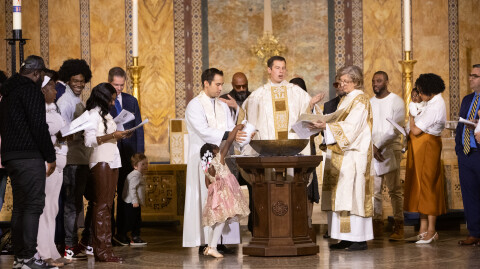Imagine that you are a film composer and you have been given the assignment to score Jesus’ triumphant entry into Jerusalem. What kinds of sounds would you choose? What types of feelings would you try to evoke?
Personally, I’d pick a layered approach: clashing melodies both major and minor; stately celebration mixed with eerie premonition. The mood should be festive, of course. The crowd joyfully acclaims Jesus, lauding him as king. But the Palm Sunday scene is no ordinary coronation. “Order your disciples to stop!” bark a few voices who seem to be actively attempting to impede the proceedings. The same popularity that drew an impressive crowd to view the jubilant procession now poses a distinct threat to the political and religious leaders of Jerusalem. Committed as they are to retaining their power, they make it their mission to thwart Jesus at every turn and ultimately display a willingness to become violent and extinguish him by force.
Jesus knew when he got on that donkey what was about to happen to him. The Gospels make extremely clear that Jesus anticipated his death and the opposition that would incite it. Even if the crowds were unrestrained in their joy that morning, it’s hard to believe that Jesus was feeling all that happy as he walked along the road to Jerusalem. He understood what awaited him there; he was aware of the pain that was about to come; he had to realize that his hike to the Holy City was a death march.
And yet, throughout my priestly ministry, I’ve heard cries to make Palm Sunday cheerier. For many, the Passion—the story of Jesus’ trial and death—seems to get in the way of the brightness they think should characterize the Sunday before Easter. Some fervently believe the rumor that church authorities inserted the Passion into Palm Sunday services because not enough people were attending church on Good Friday. I myself was under this impression for many years!
But it’s not true. The Passion Gospel has been read on Palm Sunday for over a millennium. In the medieval Church, it was the custom to read each of the Passion narratives during Holy Week: Matthew on Palm Sunday, Mark on Holy Tuesday, Luke on Holy Wednesday, and John on Good Friday. In fact, it was the “palm” part of Palm Sunday that, for several hundred years, was officially absent from the Eucharistic liturgy for the “Sunday next before Easter, commonly called Palm Sunday” in Anglican/Episcopal contexts. Even after it returned to the Book of Common Prayer in 1979, it was intentionally separated from the main body of the service, now called The Sunday of the Passion: Palm Sunday (note that “Palm Sunday” comes second). The palm procession was never intended to be the primary focus of worship on the Sunday before Easter.
Why so many Episcopalians and other Christians remember a Palm Sunday without a Passion reading is a dissertation for another venue, but I find it interesting to reflect on why so many resist its current inclusion. I can’t help but think it has something to do with Americans’ relentless desire to pursue happiness in any and all circumstances and corresponding instinct to minimize the reality of suffering, struggle, and pain.
In our current Book of Common Prayer, there’s an optional collect for Palm Sunday that states that Jesus “went not up to joy but first he suffered pain, and entered not into glory before he was crucified.” Jesus’ resurrection, it suggests, is intimately connected to the gruesome death he suffers. He doesn’t defeat death without facing and enduring it first.
I invite you, this year, to allow your shouts of “All glory, laud, and honor” to be tainted by an uncomfortable sense of foreboding. Perhaps by holding back on full-throated celebration until the splendor of Easter Day you might more fully understand the journey that Jesus takes.

The Reverend Peter D. Thompson
Vicar



